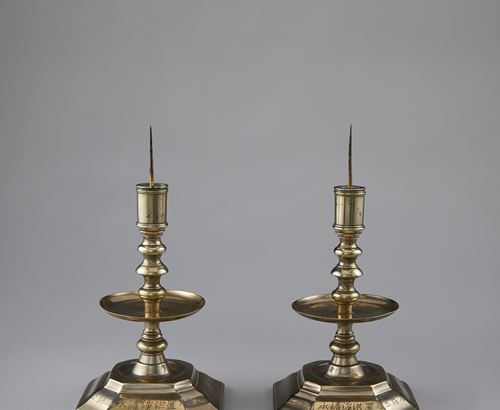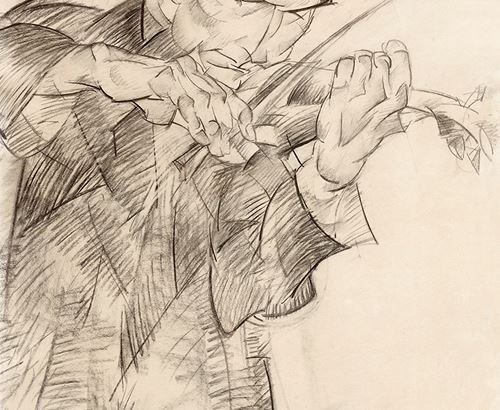A pair of biscuit porcelain figures, Justice and Peace by Dihl et Guérhard, Paris
description
both marked: ‘Mfre de Mgr le duc d’Angoulême à Paris’
Material: biscuit porcelain on a green porcelain base with gilt-bronze mounts.
Régine Plinval de Guillebon, ‘La Manufacture de Porcelaine de Guérhard et Dihl dite du duc d’Angoulême’, French Porcelain Society, IV, 1988, p. 17-21, p.19
Provenance
Private collection, Paris
Literature
Régine Plinval de Guillebon, ‘La Manufacture de Porcelaine de Guérhard et Dihl dite du duc d’Angoulême’, French Porcelain Society, IV, 1988, p. 17-21, p.19
Detail Description
Two biscuit porcelain figures of lady’s on green porcelain base with gilt-bronze mounts. The bronze mounts reveal the titles of these figures. The lady with the sword depicts Justice. She holds a scale in her left hand. This balance rests on a pedestal. The scales represent the weighing of evidence. Peace is recognizable by her cornucopia for the prosperity. She hides the armour with triumphant flags.
These two porcelain statues were made in Paris in the factory of Dihl et Guérhard. This factory was without a doubt the most prestigious of all the Parisian porcelain manufactories. It was also known as the Duc d’Angouleme porcelain factory since it stood under his protection. The factory was active from 1781 until 1828. The History and success of the factory were published in 1972 in the indispensable book Porcelaine de Paris 1770-1850 by Régine Plinval de Guillebon.
Dihl et Guérhard was founded by Christophe Dihl (1752-1830) and Antoine Guérhard (d.1793). Dihl was a chemist, and the factory experimented with new colours and finishes. His technological expertise must have been considerable because the quality of the factory’s products was very high.
From an early stage, the factory operated under the protection, though not the ownership, of Louis Antoine, Duke of Angoulême, (1775-1844), a nephew of the reigning Louis XVI of France, despite the fact that he was only five at the time that his protection of the factory was granted. Royal protection enabled the factory to make and sell coloured and gilt porcelain despite the monopoly granted to Sèvres in 1766.
The Duke's name was dropped during the French Revolution. Since this pair is marked with his name, these two biscuits can be dated between 1781 and 1789, the first decade the factory was running. The mark ‘Mfre de Mgr le duc d’Angoulême à Paris’ was an abbreviated version of the formal name "Manufacture de Monsieur Le Duc d’Angoulême.
By 1785, the factory employed thirty painters and twelve sculptors and it soon outgrew its original quarters on the rue de Bondy and moved to new premises on the rue du Temple in 1789.
Under the clientele was the American diplomat Gouverneur Morris (1752-1816) who visited Dihl et Guérhard several times often acting on behalf of president George Washington (1732-1799). He noted: “We find that the porcelain here is more elegant and cheaper than it is at Sèvres.” Dihl also asked the London merchant Thomas Flight to sell his porcelain in England for a period of six years beginning in 1789.
Régine Plinval de Guillebon made a list about the figures, groups, and clocks from the factory, including biscuit groups depicting “La Justice ” and “La Paix ” by the sculptor, Charles Gabriel Sauvage, called Lemire.
The sculptor and modeller Charles Gabriel Sauvage, called Lemire, was born in Lunéville in 1741 and died in Paris 1827. He is also the artist of the figure group in unglazed porcelain depicting the French king Louis XVI and American statesman Benjamin Franklin commemorating the signing of two treaties between France and the United States in 1778, which is in the Metropolitan Museum of Art in New York.
A second pair of this biscuit group depicting La Justice and La Peace is also in the collection of the Metropolitan Museum of Art in New York. Here the two statues are titles Justice and War. Since they lack the bronze titles on the base this confusion is argumentative. As the list published by Régine de Plinval de Guillebon doesn’t name a war figure and because these two have the names in gilt-bronze we can safely state this pair is Justice and Peace by Charles Gabriel Sauvage, called Lemire.
contact
Daatselaar The Collection






